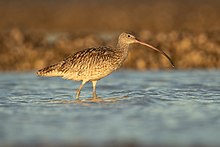Far Eastern curlew
| Far Eastern curlew | |
|---|---|

| |
| Scientific classification | |
| Domain: | Eukaryota |
| Kingdom: | Animalia |
| Phylum: | Chordata |
| Class: | Aves |
| Order: | Charadriiformes |
| Family: | Scolopacidae |
| Genus: | Numenius |
| Species: | N. madagascariensis
|
| Binomial name | |
| Numenius madagascariensis (Linnaeus, 1766)
| |
| Synonyms[2] | |
|
Scolopax madagascariensis Linnaeus, 1766 | |
The Far Eastern curlew (Numenius madagascariensis) is a large shorebird most similar in appearance to the long-billed curlew, but slightly larger. It is mostly brown in color, differentiated from other curlews by its plain, unpatterned brown underwing. It is not only the largest curlew but probably the world's largest sandpiper, at 60–66 cm (24–26 in) in length and 110 cm (43 in) across the wings.[3] The body is reportedly 565–1,150 g (1.246–2.535 lb), which may be equaled by the Eurasian curlew.[4] The extremely long bill, at 12.8–20.1 cm (5.0–7.9 in) in length, rivals the bill size of the closely related long-billed curlew as the longest bill for a sandpiper.[3]
Taxonomy
In 1760 the French zoologist
Distribution and habitat


The Far Eastern curlew spends its breeding season in northeastern Asia, including Siberia to Kamchatka, and Mongolia. Its breeding habitat is composed of marshy and swampy wetlands and lakeshores. Most individuals spend the non-breeding season in coastal Australia, with a few heading to South Korea, Thailand, Philippines and New Zealand, where they stay at estuaries, beaches, and salt marshes. During its migration the Far Eastern curlew commonly makes stopovers on the mudflats of the Yellow Sea.
It uses its long, decurved bill to probe for invertebrates in the mud. It may feed in solitary but it generally congregates in large flocks to migrate or roost. Its call is a sharp, clear whistle, cuuue-reee, often repeated.
Diet
On its breeding grounds the Far Eastern curlew consumes insects, such as larvae of beetles and flies, and amphipods. During migration it also feeds on berries. In the non-breeding season, it consumes marine invertebrates, preferring crabs and small molluscs but also taking other crustaceans and polychaetes.[1]
Conservation status
As of 2006, there are an estimated 38,000 individuals in the world. Formerly classified as least concern by IUCN, it was found to have been rarer than previously believed and thus its status was uplisted to "vulnerable" in the 2010 IUCN Red List of threatened species.[1]
In Australia its status under the Environment Protection and Biodiversity Conservation Act is "critically endangered".[8]
Threats
Its population decline has been linked[9] to the massive tidal flat reclamations by China, North Korea and South Korea along the coasts of the Yellow Sea, which have caused a greater than 65% loss of mudflats[10] where the Far Eastern curlew makes stopovers.[9]
References
- ^ . Retrieved 8 December 2021.
- ^ Australian Biological Resources Study (12 February 2010). "Species Numenius (Numenius) madagascariensis (Linnaeus, 1766)". Australian Faunal Directory. Canberra, Australian Capital Territory: Department of the Environment, Water, Heritage and the Arts, Australian Government. Retrieved 13 December 2018.
- ^ ISBN 978-0-7136-3509-6.
- ISBN 978-0-8493-4258-5.
- ^ Brisson, Mathurin Jacques (1760). Ornithologie, ou, Méthode contenant la division des oiseaux en ordres, sections, genres, especes & leurs variétés (in French and Latin). Vol. 5. Paris: Jean-Baptiste Bauche. pp. 321–24, Plate 28. The two stars (**) at the start of the section indicates that Brisson based his description on the examination of a specimen.
- ^ hdl:2246/678.
- ^ Linnaeus, Carl (1766). Systema naturae : per regna tria natura, secundum classes, ordines, genera, species, cum characteribus, differentiis, synonymis, locis (in Latin). Vol. 1, Part 1 (12th ed.). Holmiae (Stockholm): Laurentii Salvii. p. 242.
- ^ Department of the Environment, Numenius madagascariensis — Eastern Curlew, accessed 30 May 2015 http://www.environment.gov.au/cgi-bin/sprat/public/publicspecies.pl?taxon_id=847
- ^ Wikidata Q33587083.
- Wikidata Q55868653.
Further reading
- O'Brien, Michael et al. (2006). The Shorebird Guide. New York: Houghton Mifflin. ISBN 0-618-43294-9
- A Yellow Sea species account

